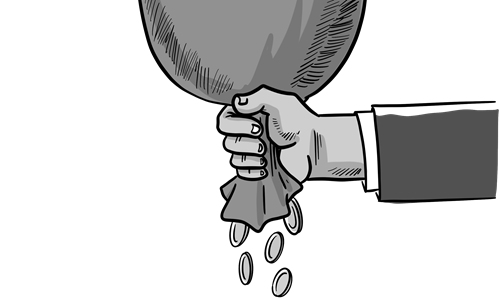HOME >> SOURCE
How can the PBC avoid the tide of QE?
By Zheng Chaoyu Source:Global Times Published: 2019/12/2 22:03:40

Illustration: Luo xuan/GT
The US Federal Reserve's (Fed's) interest rate cuts have started a trend among central banks which is widely expected to continue in 2020. In this context, Yi Gang, governor of the People's Bank of China (PBC), China's central bank, said in a signed article published on Sunday that China will not resort to quantitative easing (QE) even as the world's major economies are approaching interest rates of zero. How can the PBC maintain normal monetary policy amid a rising tide of QE? It can do this because the slowdown pressure on the Chinese economy is fundamentally different from the economic crisis that occurred in Western economies. A flood-like monetary stimulus policy is not indispensable for China.This round of QE, which was first introduced by the US to deal with the devastating impacts of the 2008 financial crisis, is facing the challenge of losing its economic stimulus effect in major developed countries while bringing more side effects. In 2008, normal monetary policy had lost its effectiveness in dealing with the impact of a financial crisis. The introduction of QE effectively resolved the problems and prevented economies and asset prices from spiraling downward, but now it is no longer working. What the ultra-loose monetary policy generally does is to provide liquidity to the economy, presenting a zero or negative-interest environment to boost economic growth.
However, in the long run, the stimulus policy will in turn delay the structural reform of economies, exacerbating existing structural problems. In recent years, the interest rates of major developed economies have been moving faster than their corresponding economic growths and inflation levels have been declining. The marginal effects of interest cuts and QE are being eliminated. Due to high debts, weak growth momentum and lingering deflationary pressures, major developed economies are being forced to "normalize" such unconventional monetary policies. The current downward pressure on the Chinese economy is fundamentally different from the economic and financial crisis that occurred in Western countries. Although the Chinese economy is faced with the impacts of a bruising China-US trade war, global economic downward pressure and an overlap of structural and cyclical problems, its growth is still at a reasonable level. China's economy continues to maintain a medium-high level of economic growth. This can be seen clearly in the steady progress of its economic restructuring and optimization, the development of high-tech, high-end industries, the continual increase of consumption as a proportion of economic growth and the stable employment rate.
This is why China's economy will continue to adopt a prudent and targeted monetary policy, and why it doesn't resort to beggar-thy-neighbor actions and competitive exchange rate policies. China will insist upon the fundamental goal of stabilizing the yuan's exchange rate and strengthening its guard of financial risks so as to build a proper monetary environment for promoting economic growth.
China has ample monetary policy tools and relatively large policy room to support its economy. There are preferential conditions both overseas and at home. The world's major economies are taking measures to prevent deflation, providing low interest rates and low-inflation external conditions for the Chinese economy, which are preferential for China when taking measures to stimulate economic growth. Additionally, the domestic inflation is also at a relatively moderate level. Factors such as the rise in pork prices and the rise in prices of agricultural and sideline products are temporary phenomena. They are affected by the cyclical nature of agricultural products, and they will not affect the overall inflation level much, let alone squeeze the adjustment space of monetary stimulus policies.
China will continue to adopt a steady monetary policy and take countercyclical adjustment measures in order to keep liquidity reasonably abundant and to provide targeted stimulus to specific sectors. The monetary policies of major developed countries are still increasing liquidity, but China's monetary policy has targeted measures which offer specific encouragements and restrictions to specific sectors. In the next phase, China will continue to improve and complete policy tools based on practical needs and strengthen weak links, supporting structural optimization.
The author is a professor of macroeconomic analysis, monetary policy with School of Economics, Renmin University of China. bizopinion@globaltimes.com.cn
Posted in: INSIDER'S EYE